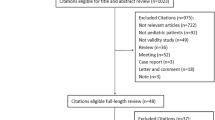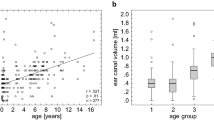Abstract
Most publications that deal with infrared tympanic thermometry (ITT) have performed a comparison between the established temperature measurements and ITT. However, to date an understanding of the influence of pathological ear findings on ITT test results is incomplete. Therefore, in the present study ITT was performed in healthy adults ( n =21), adult patients with monaural central perforation ( n =31) or strong scar formations ( n =24) of the tympanic membrane and 18 adult patients after monaural canal wall down surgery. Right and left ear and oral temperature were measured three times by one investigator in a room with a constant temperature of 20–22°C. Between every measurement there was a free time interval of 2 min. In healthy adults (36.50°C vs. 36.51°C) patients with monaural central perforation of the tympanic membrane (36.41°C vs. 36.34°C) and with monaural strong scar formations in the tympanic membrane (36.39°C vs. 36.45°C), no significant difference between the right and left ear could be proved. In contrast to this, a significantly higher temperature in the surgically treated ear compared to the healthy side (36.97°C vs. 36.31°C; P <0.001) occurred in patients with a status of after monaural canal wall down surgery. In summary, it could be demonstrated that, in contrast to minor ear surgery, major ear surgery such as canal wall down has a significant influence on the results of ITT. If a patient’s history gives reference to previous ear surgery, an otoscopic examination is necessary in order to exclude the presence of an after-canal-wall-down surgery status and thus to avoid false ITT test results.
Similar content being viewed by others
References
Anyutin RG, Ivkina SV, Dmitriev NS, Mileshina NA (2004) Tympanic thermometry in diagnosis of exudative otitis media in children. Vestn Otorinolaringol 2:33–35
Benzinger M (1969) Tympanic thermometry in surgery and anesthesia. JAMA 209:1207–1211
Brennan DF, Falk JL, Rothrock SG, Kerr RB (1995) Reliability of infrared tympanic thermometry in the detection of rectal fever in children. Ann Emerg Med 25:21–30
Cusson RM, Madonia JA, Taekman JB (1997) The effect of environment on body site temperatures in full-term neonates. Nurs Res 46:202–207
Doezema D, Lunt M, Tandberg D (1995) Cerumen occlusion lowers infrared tympanic membrane temperature measurement. Acad Emerg Med 2:17–19
Fritz U, Rohrberg M, Lange C, Weyland W, Brauer A, Braun U (1996) Infrarot Temperaturmessung im Gehörgang mit dem iDIATEK 9000 Instatemp und dem DIATEK 9000 Thermoguide. Vergleich mit Methoden der Temperraturmessung an anderen Körperstellen. Anaesthesist 45:1059–1066
Garcia Callejo FJ, Platero ZA, Sebastian GE, Marco SM, Alpera Lacruz RJ, Martinez Beneyto MP (2004) Condicionantes otologicos en termometria timpanica con infrarrojos en ninos. Acta Otorrinolaringol Esp 55:107–113
Hasel KL, Erickson RS (1995) Effect of cerumen on infrared ear temperature measurement. J Gerontol Nurs 21:6–14
Holtmann S (1999) Ohrthermometrie aus otologischer Sicht. Laryngorhinootologie 78:9–11
Huang HP, Shih HM (1998) Use of infrared thermometry and effect of otitis externa on external ear canal temperature in dogs. J Am Vet Med Assoc 213:76–79
Hughes WT, Patterson GG, Thornton D, Williams BJ, Lott L, Dodge R (1985) Detection of fever with infrared thermometry: a feasibility study. J Infect Dis 152:301–306
Irvin SM (1999) Comparison of the oral thermometer versus the tympanic thermometer. Clin Nurse Spec 13:85–89
Jolin SW, Howell JM, Milzman DP, Stair TO, Butzin CA (1995) Infrared emission detection tympanic thermometry may be useful in diagnosing acute otitis media. Am J Emerg Med 13:6–8
Kelly B, Alexander D (1991) Effect of otitis media on infrared tympanic thermometry. Clin Pediatr (Phila) 30:46–48
Mandell DL, Pearl AW, Rothschild MA (2001) Influence of minor ear surgery on infrared tympanic thermometry. Arch Otolaryngol Head Neck Surg 127:547–552
Modell JG, Katholi CR, Kumaramangalam SM, Hudson EC, Graham D (1998) Unreliability of the infrared tympanic thermometer in clinical practice: a comparative study with oral mercury and oral electronic thermometers. South Med J 91:649–654
Porwancher R, Sheth A, Remphrey S, Taylor E, Hinkle C, Zervos M (1997) Epidemiological study of hospital-acquired infection with vancomycin-resistant Enterococcus faecium: possible transmission by an electronic ear-probe thermometer. Infect Control Hosp Epidemiol 18:771–773
Pransky SM (1991) The impact of technique and conditions of the tympanic membrane upon infrared tympanic thermometry. Clin Pediatr (Phila) 30:50–52
Robb PJ, Shahab R (2001) Infrared transtympanic temperature measurement and otitis media with effusion. Int J Pediatr Otorhinolaryngol 59:195–200
Rohrberg M, Fritz U, Weyland W, Braun U (1997) Temperaturmessung im Gehörgang: Vergleich der Infrarotthermometrie mit konventioneller Temperaturbestimmung und Evaluation von klinischen Faktoren auf die Infrarotmessung. Anasthesiol Intensivmed Notfallmed Schmerzther 32:409–413
Shambaugh GE Jr (1969) Tympanic thermometry during anesthesia. Arch Otolaryngol 90:544
Shinozaki T, Deane R, Perkins FM (1988) Infrared tympanic thermometer: evaluation of a new clinical thermometer. Crit Care Med 16:148–150
Tabor MW, Blaho DM, Schriver WR (1981) Tympanic membrane perforation: complication of tympanic thermometry during general anesthesia. Oral Surg Oral Med Oral Pathol 51:581–583
Talo H, Macknin ML, Medendorp SV (1991) Tympanic membrane temperatures compared to rectal and oral temperatures. Clin Pediatr (Phila) 30:30–33
Tomkinson A, Roblin DG, Quine SM, Flanagan P (1996) Tympanic thermometry and minor ear surgery. J Laryngol Otol 110:454–455
Wallace CT, Marks WE, Jr., Adkins WY, Mahaffey JE (1974) Perforation of the tympanic membrane, a complication of tympanic thermometry during anesthesia. Anesthesiology 41:290–291
Zehner WJ, Terndrup TE (1991) The impact of moderate ambient temperature variance on the relationship between oral, rectal, and tympanic membrane temperatures. Clin Pediatr (Phila) 30:61–64
Author information
Authors and Affiliations
Corresponding author
Rights and permissions
About this article
Cite this article
Schmäl, F., Loh-van den Brink, M. & Stoll, W. Effect of the status after ear surgery and ear pathology on the results of infrared tympanic thermometry. Eur Arch Otorhinolaryngol 263, 105–110 (2006). https://doi.org/10.1007/s00405-005-0966-6
Received:
Accepted:
Published:
Issue Date:
DOI: https://doi.org/10.1007/s00405-005-0966-6




